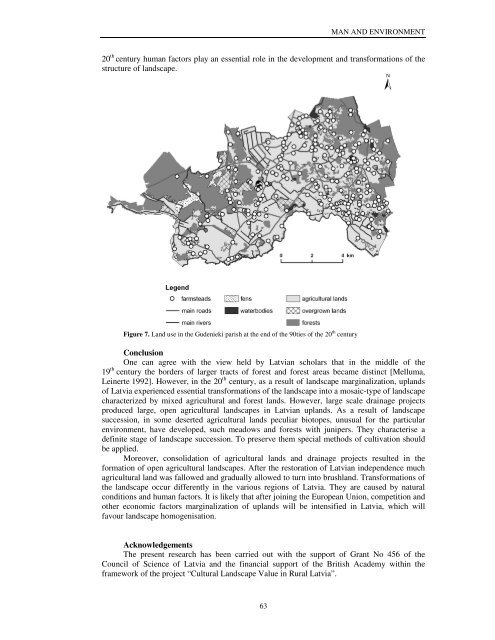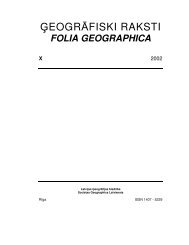eogrÄfiski raksti folia geographica xii - Ä¢eogrÄfijas un Zemes zinÄtņu ...
eogrÄfiski raksti folia geographica xii - Ä¢eogrÄfijas un Zemes zinÄtņu ...
eogrÄfiski raksti folia geographica xii - Ä¢eogrÄfijas un Zemes zinÄtņu ...
Create successful ePaper yourself
Turn your PDF publications into a flip-book with our unique Google optimized e-Paper software.
63<br />
MAN AND ENVIRONMENT<br />
20 th century human factors play an essential role in the development and transformations of the<br />
structure of landscape.<br />
Figure 7. Land use in the Gudenieki parish at the end of the 90ties of the 20 th century<br />
Conclusion<br />
One can agree with the view held by Latvian scholars that in the middle of the<br />
19 th century the borders of larger tracts of forest and forest areas became distinct [Melluma,<br />
Leinerte 1992]. However, in the 20 th century, as a result of landscape marginalization, uplands<br />
of Latvia experienced essential transformations of the landscape into a mosaic-type of landscape<br />
characterized by mixed agricultural and forest lands. However, large scale drainage projects<br />
produced large, open agricultural landscapes in Latvian uplands. As a result of landscape<br />
succession, in some deserted agricultural lands peculiar biotopes, <strong>un</strong>usual for the particular<br />
environment, have developed, such meadows and forests with j<strong>un</strong>ipers. They characterise a<br />
definite stage of landscape succession. To preserve them special methods of cultivation should<br />
be applied.<br />
Moreover, consolidation of agricultural lands and drainage projects resulted in the<br />
formation of open agricultural landscapes. After the restoration of Latvian independence much<br />
agricultural land was fallowed and gradually allowed to turn into brushland. Transformations of<br />
the landscape occur differently in the various regions of Latvia. They are caused by natural<br />
conditions and human factors. It is likely that after joining the European Union, competition and<br />
other economic factors marginalization of uplands will be intensified in Latvia, which will<br />
favour landscape homogenisation.<br />
Acknowledgements<br />
The present research has been carried out with the support of Grant No 456 of the<br />
Co<strong>un</strong>cil of Science of Latvia and the financial support of the British Academy within the<br />
framework of the project “Cultural Landscape Value in Rural Latvia”.

















